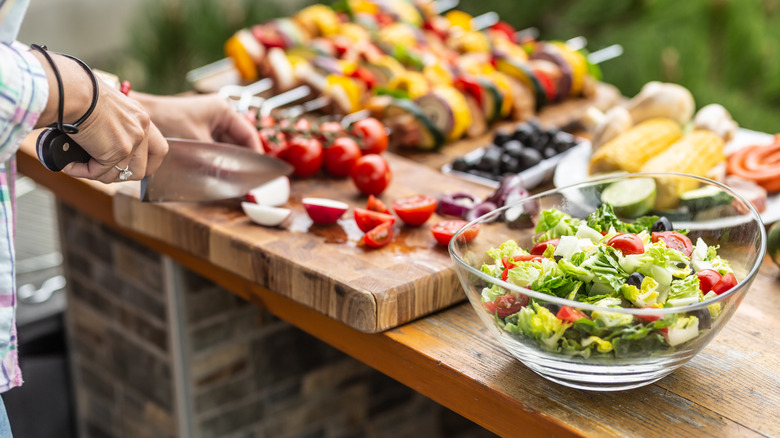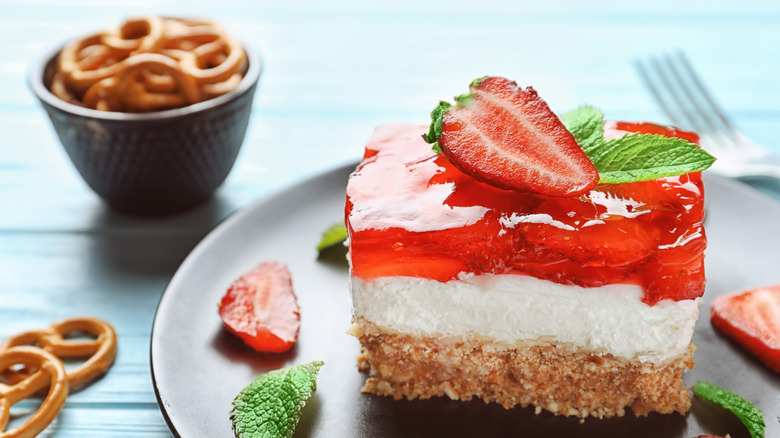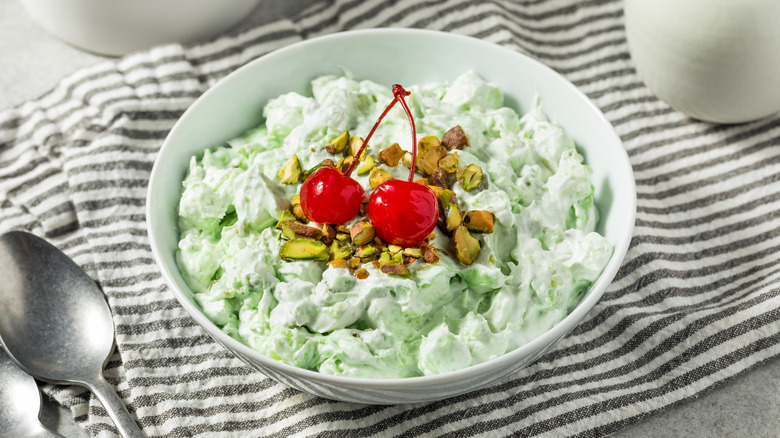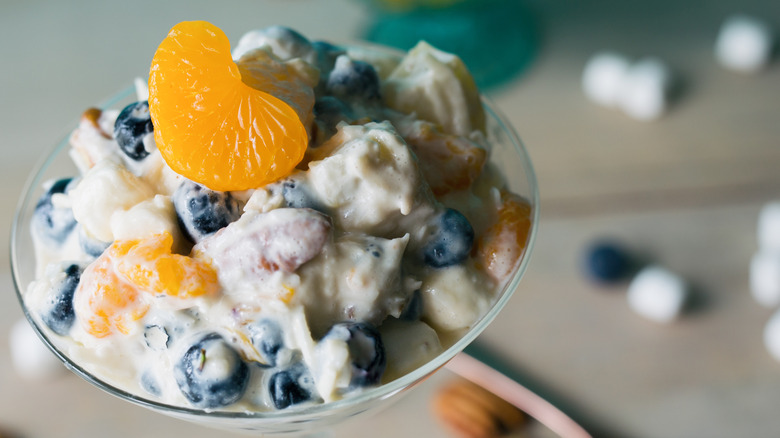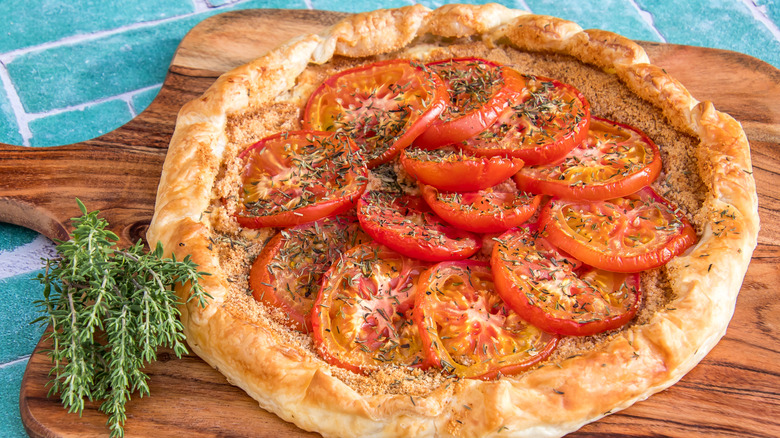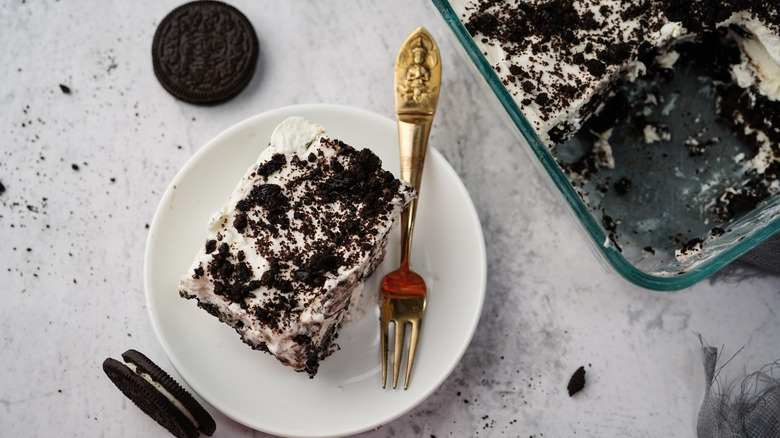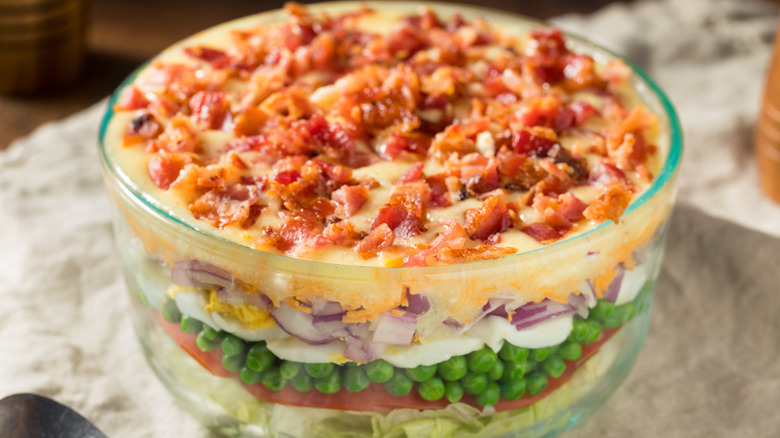7 Classic Summer Foods You Rarely See Anymore
Summer is a season defined by its food. Some classic seasonal favorites have stood the test of time, evolving and transforming with our tastes. But for all the delicious staples that have stuck around, other summer foods eventually stopped being classic. In fact, some virtually disappeared altogether, while others became so regional the mass public may not even be aware of them.
That some foods slip into obscurity is not a surprise; it's the reason you rarely see lobster Thermidor on menus nowadays. But some of these classic summer foods were almost synonymous with the season — and, believe it or not, with the future of food. Time moves quickly, though, and so do trends in the food world. Do these summer delicacies deserve to be remembered and recreated again? Or should they remain as delicious — if dated — fancies of the past? Let's take a closer look at some former summer classics.
Strawberry pretzel salad
Of all the little-remembered classic summer foods, none might be as worthy of a memory reprieve as the strawberry pretzel salad. Sweet and wobbly strawberry gelatin (with real strawberries, naturally) atop a creamy, almost cheesecake-like middle, atop a buttery pretzel crust, strawberry pretzel salad really does bring the works. It's light, refreshing, and very well-balanced, exactly the kind of summer dessert you'd want on a hot day. (Although it may ask you to stretch your definition of "salad" a bit.)
Despite its immense popularity, the origin of the strawberry pretzel salad is shrouded in mystery. Allegedly, it came from the American South sometime in the mid-20th century as other gelatin salads rose in popularity (more on those in a bit). However, that story fails to explain the pretzel crust or the cream cheese middle. Equally mysterious is why something this fun faded from popular consciousness, although it may have something to do with the end of Jello as a novelty food. Strawberry pretzel salad might be undergoing something of a new cultural moment, so don't be shocked if this layered luxury shows up at your next potluck.
Watergate salad
This unusually emerald dessert has much longer history than even its name implies; there's evidence that it actually first came into being in the early 20th century with the initial rise of instant gelatin mixes; in those days, it was called a delight, and was all about the pineapple. But this dish didn't get its distinct hue or its official name until the late 1970s, when pistachio pudding mix hit the market and the greatest political scandal in modern American history ousted a president.
Of course, the obvious question is why a mixture of whipped cream, pistachio pudding, pineapple chunks, and chopped nuts would be named after the Watergate scandal. Was it some kind of political joke? And if so, in what way? No one truly knows; you'd be hard pressed to make the connection between pistachios and Richard Nixon. It was never officially served at the Watergate hotel restaurant, either. It may have something to do with the Watergate cake, which also has a greenish tint and lots of nuts. Yet since no one can agree why the cake is called that, the confusion remains. Regardless, it eventually fell out of fashion even as "Watergate" has remained a synonym for political scandals. Maybe the joke was that it wouldn't last, much like Nixon's career. Or perhaps that's overthinking it — it could be someone's idea of deliciously edgy humor.
Ambrosia dessert salad
Whether or not ambrosia, named for the food of the gods in Greek mythology, should be considered a fruit salad is a subject of some debate. Equally debatable is what defines ambrosia; there is so much controversy around it, it's actually dizzying. Arguments range from whether this mixture of whipped topping, sour cream, and fruit should include marshmallows, whether it should be light or heavy, whether it require coconut, and if so, if canned coconut is acceptable. Also up for debate? Whether this is a summer or winter food.
For plenty of classic summer foods aficionados, a mixture of fruit and cream or pudding seems ideal. It's basically a fruit salad with the yogurt dipping sauce mixed in, and also maybe there are marshmallows. No wonder it dominated from the 1940s straight through to the '80s and is considered an old-school classic. Yet in the South, ambrosia is considered a staple of the holiday table. In fact, it's still fairly popular in the South to this day, even as its presence across the rest of America has waned. Much like the Greek gods of yore, ambrosia seems like a distant memory.
Tomato tart (or tomato pie)
With a history stemming from the elegance of French cooking and recipes dating back to before the Civil War, tomato tarts are traditionally baked on puff pastry and feature full slices of tomatoes or whole cherry tomatoes roasted until sweet and juicy. Oftentimes, the tomatoes are baked on top of cheese, but that doesn't mean we've got pizza on our hands, either, which might explain why tomato tarts haven't maintained the culinary prominence they once had. They're certainly not as common anymore, but you might be able to find some depending on where you're located and when tomatoes are at their freshest.
Tomato pies are in a similar category, though we're still not talking about pizza without cheese (which is also referred to as tomato pie depending on locale). These are fully baked pies with crust and, rather than fruit, have tomatoes stuffed in side. It's a dish that, like many simple tomato dishes, originated the South and saw its shining glory in summertime. That glory has faded, though. Tomato pies surely haven't completely gone away, but we know that sweet pies tend to dominate the cultural conversation here in the United States.
Icebox cake
The appeal of the icebox cake lies in its simplicity: layer graham crackers, crispy cookies, wafers, or a graham cracker crust over whipped cream, pudding, or a similar creamy, high-moisture sweet and let it chill overnight. The result is tender and extremely refreshing yet sliceable thanks to the lingering structure of the graham crackers or cookies. The sky is truly the limit in terms of flavor combinations and ingredients, adding to its charm. For years, a cookies-and-cream icebox cake was considered an absolute summer classic.
With the advent of the refrigerator in the early 20th century, iceboxes became all the rage as a dessert and even experienced a resurgence in the 1950s with the demand for convenience in the kitchen. However, time and changing tastes caused it to gradually disappear from the dessert table, even while its older cousin the trifle continues to dominate in British cooking. Nabisco even discontinued its Famous Chocolate Wafers, a necessity of that beloved cookies-and-cream icebox cake, in 2023. If that isn't a sign of icebox cake's loss of status, nothing is. However, there might be a resurgence on the horizon. Keep your eyes peeled and your spoon ready.
Seven-layer salad
Unlike dessert salads, the seven-layer salad is more recognizable as a salad to our modern sensibilities. It does, after all, feature lettuce and green peas. It also features layer upon layer of indulgence: bacon, cheese, mayo dressing, and even some hard-boiled eggs, all lovingly laid out in a glass dish to really show off the layers (the glass dish, according to everyone, is a necessity). The question is whether all of those other ingredients overshadow the "salad" aspect of the dish.
Much like icebox cakes, seven-layer salads came to prominence in the 1950s and 1960s when convenience was king in the kitchen. It also gained appeal because there's a lot of customization possibilities, allowing home cooks to add their personal favorites as desired. Seven-layer salad still has a following in the American Midwest, where it's still a feature of summer potlucks and sports parties. However, as culinary tastes moved toward salads with less fat content and less sugar, seven-layer salad gradually lost its place at the picnic table. Surprisingly, seven-layer salad is often considered sweet, which may also have played a part in its more limited appeal over time.
Gelatin salad
We've already had some jiggly entrants on this list, but the broad category of gelatin salad deserves a shout, too. The history of gelatin reaches way back to the 15th century, although it only achieved mass popularity when instant gelatin became available in the early 20th century. Prior to that, it was too expensive and labor-intensive to be eaten by anyone other than the very rich. Then, in the postwar era, gelatin exploded. The people of the 1950s and 1960s saw gelatin as an incredible novelty, even the food of the future, in part because of its obvious artificiality.
Then people started (or rather, restarted or rediscovered, given the food's long history) adding other foods to their gelatin molds, like fruits for dessert gelatins or hardboiled eggs for savory gelatins (often made with aspic). And thus the gelatin salad became a mainstay across the country, particularly in summertime. Think seasonal veggies (cucumbers and tomatoes) and fruits (cherries and strawberries) as well as countless other ingredients. Sweet gelatin remains popular, of course, but gelatin salads — both sweet and savory — have mostly gone by the wayside, and rarely will you find one served at a summer picnic or cookout. Although some people are interested in seeing a revival of aspic gelatin salads, they face a significant uphill battle against a very different culinary landscape than the one that saw them rise to prominence.

